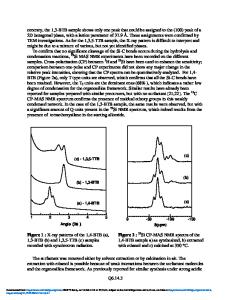Porous silica derived from chitosan-containing hybrid composites
- PDF / 287,761 Bytes
- 8 Pages / 612 x 792 pts (letter) Page_size
- 82 Downloads / 374 Views
. Yazdani-Pedram Departamento de Quimica Orgánica y Físico Quimica, Facultad de Ciencias Químicas y Farmacéuticas, Olivos 1007, Casillo 233, Santiago, Chile and Centro para la Investigación Interdisciplinaria Avanzada en Ciencia de los Materiales (CIMAT), Av. Beaucheff 850, Casilla 2777, Santiago, Chile (Received 11 April 2002; accepted 21 November 2002)
In this paper, we report the preparation by the sol-gel technique of organic–inorganic hybrid composites containing the biopolymer chitosan incorporated in a siloxane-based inorganic network. The hybrid xerogels were transformed into porous silica particles by elimination of the organic phase. Surface characteristics of the silica samples can be easily tailored. In this way Brunauer–Emmett–Teller areas, pore volume, and pore diameter of the prepared silica can be predetermined within a wide range. Morphology of the particles at longer length scales can be designed to obtain either irregularly shaped particles with layered morphology or spherical particles. The results are explained on the basis of the cationic polyelectrolytic properties of chitosan, which allows easy association with siloxane oligomers, the precursors of silica in forming hybrid nanocomposites. I. INTRODUCTION
Polymer hybrids are composites of organic polymers with inorganic components blended at the level of molecular dispersions and can be prepared in solution through sol-gel processing. Silica-based hybrids are the most widely studied materials in which the inorganic matrix is formed by the sol-gel reaction. A controlled sequence of hydrolyses and condensations starting from an alkoxysilane-like tetraethyl orthosilicate (TEOS) in alcohols and other polar solvents leads to a solution or colloidal suspension of siloxane polymers (sol). At this stage, or at the beginning of the process, it is possible to incorporate a soluble organic polymer in the sol. The basic reactions are −Si −OEt + H2O → −Si −OH 共Hydrolysis兲 −EtOH
−Si −OH + EtO− Si − → − Si −O− Si − 共Condensation兲 −EtOH
Further cross-condensations between siloxane polymers in the sol lead to the formation of a gel precursor of the silica matrix. In hybrid syntheses, organic polymer is present in the sol and can be dispersed homogeneously in the silica gel. Condensation between silanol groups consolidates the silica network largely during further thermal treatment of the gel. −Si −OH + HO− Si → − Si −O− Si − −H2O
J. Mater. Res., Vol. 18, No. 2, Feb 2003
http://journals.cambridge.org
Downloaded: 24 Mar 2015
Organic–inorganic polymer hybrids are attractive materials for optical devices, separation methods, sensors, structural materials, catalysts, and catalyst supports.1,2 Porosity is a key property of materials, in particular those used for the preparation of catalysts, supports, and absorbents, where high surface area and control of pore size are important goals. Great advances have been made in the modeling of model porous structures with a high degree of order by using surfactants or amphiphilic block copolymers.3,4 Moreover, the u
Data Loading...










